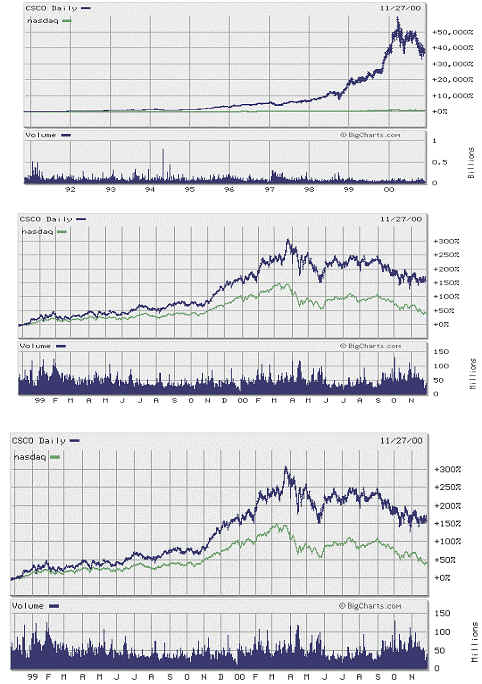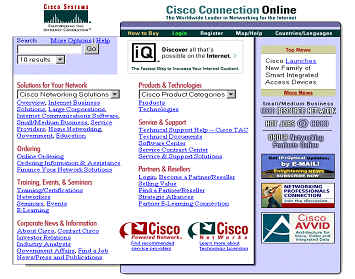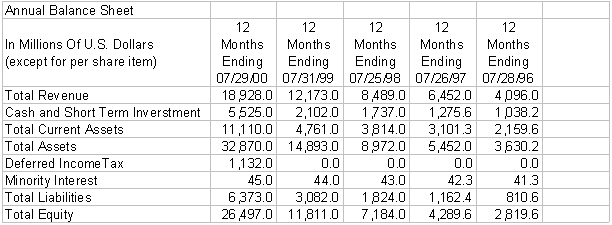|
Cisco Systems
Cisco Systems is a Business-to-Business
telecommunication network company with market capitalisation of over $3,700 billion and over 34,000 employees around the world.
The company controls more than three-quarters of the global market for
products that link networks and power the Internet, including routers and
switches. It also produces dial-up access servers and network management
software. The company has a broad set of product offerings and
technologies, which include Ethernet, Gigabit Ethernet switching, Token
Ring, ATM switching, SONET/SDH, xDSL, dial-up access, converged data,
voice, and video technologies, Tag Switching, optical transport, wireless,
content networking, call centre and unified messaging solutions,
networking security as well as network management software solutions.
Cisco typically purchases companies to acquire
technology or products that it has neither the time nor the capability to
develop itself (it has made close to 70 acquisitions since 1993, they have
acquired companies which are worth over $10 billion this year). It has an
advantage over large companies such as Oracle, which insists on developing
its own new technologies and products rather than acquiring them. This
means that Cisco can look at thousands of research projects from small
private and public companies before choosing the best, whereas Oracle has
to make decisions on where to put resources much earlier in the game.
Cisco also pursues strategic alliances with other industry leaders in
areas where collaboration can produce industry advancement and
acceleration of new market. The objective and goals for a strategic
alliance includes: technology exchange, product development, joint sales
and marketing and new-market creation.
In the Fiscal year 2000, Cisco expanded or entered
into alliances with Cap Germini/Ernst&Young, HP, Intel, IBM, KPGM
Consulting, Microsoft, Motorola, oracle, Sun Microsystems and Telcordia.
Cisco Systems was a well-regarded private company that did not become
public listed until May 1990. It was down 10% over its first four months,
but by the end of the first year it had a 155% gain. It was up 659% over
its first two years, 1,315% over its first three years, 2,470% over five
years, 7,494% over seven years and 34,930% by its ninth year (See diagram
below).

The share value of the company has been rising ever
since the company was first founded in 1990, nevertheless there were
several market corrections over the years.
The drop in share prices in May this year was one of them; it was
triggered by the release of Labour Department’s report, which showed
U.S. unemployment was at the lowest level in three decades.
Low unemployment means a tighter labour market, which tends to
drive up wages. That would
increase the chance of the Federal Reserve in raising the interest rates
as a result. Investors
panicked about the impact of further interest rate increasing, and that
was the force of the driving correction.
Tech stocks are sensitive to interest rates for
different reasons.
Their high valuations are based on low interest
rates.
Their interest payments would go up with higher
rates.
Cisco share value dropped further after an analyst
from Merrill Lynch raised the questioned of whether Cisco could maintain
its acquisition growth rate as the company would need to continue to grow
at 30% a year for the next nine years in order to sustain its current
valuation.
When Cisco’s earnings report was released in the
July’s quarter, their results exceeded the expectation of Merrill Lynch
with revenues of $5.720
billion, $245 million over the estimated value, and signs of slower US
growth have cause the investor to think that inflation pressure is at its
peaked, the share value then rebound.
The share price was brought back down again in
October even though the company reported October quarter results again
exceeded expectations. The
downtrend was the consequence of a number of reasons and the uncertainty
in the U.S. economy. They are as follows:
Profitability in numerous industries could be
affected by the outcome of the presidential election - The technology
industry is heavily influenced by the outcome of the presidency election. There is a significance difference between the key issues
raised by the two candidates, which may or may not favour the sector.
The issues are as follows: the violations of personal privacy by
e-commerce companies, taxation of interstate internet transactions,
copyright protection of entertainment material, open access, improving the
bandwidth of wireless spectrum auctions and violations of antitrust
regulations in B2B commerce.
A number of leading US technology companies
pre-announced that its revenue and earning for the September quarter would
be substantially below the expected value, this announcement results in a
down turn for the whole of the tech sector.
Finally the rising oil prices and a weakness of the
Euro have weighed on the economy sector and were seen as a negative impact
by the investor.

Cisco’s homepage (www.cisco.com)
is not particularly attractive or interesting, however the well structured
and the absence of complex animated advertisement has enable clients to
scrutinise the page without much of disruption. The homepage is linked up with other Cisco Systems around the
world with different languages, which enable customer to access the page
without the language barrier.
Cisco also offers a wide range of products for
purchases online and a step-by-step guide, which assist you throughout the
transaction. In order to keep
in touch with clients, the company encourages customers to sign up and
become a member and they will notify you with up-to-date news or when a
new product has been launched in the market.


The latest earnings report from Cisco was impressive
and again exceeded the market estimation with revenues rose 61% to 5.72
billion, almost $245 million above the estimate.
Revenues rose 16% from the previous quarter, Cisco’s eighth
consecutive quarter with double – digit sequential revenue growth.
Their router sales increased by 61% to $2.4 billion,
representing 42% of revenues, while switches sales grew by 52% to $2.3
billion, representing 40% of the revenues.
Other products, which include optical systems and professional
services, increased by 148% to $1.2 billion, or 18% of the revenues.

In the Cisco fiscal 2000 Cisco has Total Revenue of
$18,928 M and a Net Income of $2,668M, a gain of 55% and 31.9%
respectively over the year ago period.



Cash flow = (Cash and short term investment / Total
assets) * 100%
= ($5,525M / $32,870M)
* 100%
= 16.81%
Other current assets = [(Total current assets –
Cash and short term investment) / Total assets] * 100%
= [($11,110M – $5,525M) / $32,870M] * 100%
= 16.99%
Long – term assets = [(Total assets - Total current
assets) / Total assets] * 100%
= [($32,870M – $11,110M) / $32,870M] * 100%
= 66.2%
Current liabilities =[{Total liability - (Deferred
Income Tax + Minority interest)}/Total liabilities and shareholders’
equity]* 100%
=[{$6373M – ($1,132M + $45M)} / $32,870M] *100%
= 15.81%
Long – term liabilities = [(Deferred Income Tax +
Minority interest) / Total liabilities and shareholders’ equity]* 100%
= [($1,132M + $45M) / $32,870M] * 100%
= 3.58%
Shareholders’ equity = [Total Equity / Total
liabilities and shareholders’ equity]* 100%
= [$26,497M / $32,870M] * 100%
= 80.61%

Cisco Systems should not be considered as a bubble
company since the company has an ideal cash flow every fiscal year. Sales
over the Internet have risen by almost 50 % since last year and the
company’s earnings report have shown that their net income is constantly
higher than expected. These
performances reflect that the growing demand for Cisco’s access product
still remains robust. However,
despite the success from the earning reports, the share value of the
company is often in contrast, there are factors such as economical and
political reasons which can cause the share value to fluctuate.
Unlike a typical dotcom company, Cisco has a clear
business and strategic plan, which is to acquire companies with
technologies, which they are incapable to produce and to pursues strategic
alliances with other industry leaders to collaborate and produce the most
advance technology in the market.
|